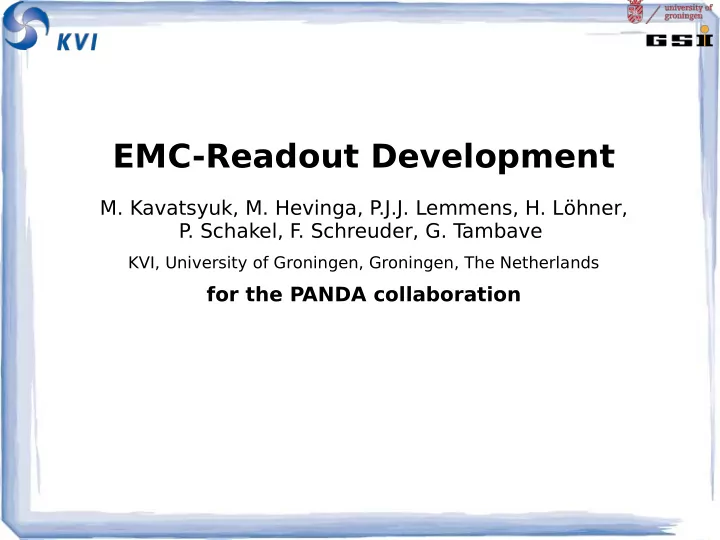

EMC-Readout Development M. Kavatsyuk, M. Hevinga, P .J.J. Lemmens, H. Löhner, P . Schakel, F . Schreuder, G. T ambave KVI, University of Groningen, Groningen, The Netherlands for the PANDA collaboration
PANDA Readout using Data links ( ) and Time distribution ( ) "SODA" [I. Konorov et al., NSS/MIC Conf. Rec., 2009 IEEE, DOI 10.1109/NSSMIC.2009.5402172] Hit detection, Detector Front-ends feature-extraction Data Combine Concentrator several Front-Ends First Stage “Event” Builder Time-ordering (building Second Stage physics events) “Event” Builder Compute Node On-line processing of complete events, Accept/reject decision 2
Readout for Electromagnetic Calorimeter EMC volume Time SADC Clock Data Distribution Sync. signals Concentrator -25°C Digitizer slow control SADC Preamp. Data Optical link concentration FPGA On-line pulse-data LAAPD Event Compute Hits-data Processing: pre-building Node Feature Extraction Key components of the readout: ● Digitizer module with on-line pulse-processing ● Data-concentrator with time-ordered output ● Synchronous optical-link connection (clock-signal distribution) ● High-level on-line data processing 3
Digitizer Prototype Hardware Current prototype Prototype in development (developed by P. Marciniewski) (is being developed by P. Marciniewski) ● 64 channels (32 inputs with shaping amplifiers and dual-range output) ● Complete SODA compatibility ● 14 bit, 80 MHz ● 16 channels ● Two Xilinx Virtex 6 FPGAs with ● 125 MHz sampling rate cross-links ● Only partial support ● Two independent optical-links of a time- connections (for redundancy) synchronisation via optical link 4
Digitizer Prototype Firmware Leading-edge of the pulse FE I Time-ordered output ADC Hi Sel ADC Low FE I MUX I ... FE II FE I: MUX I ● Base-line follower ● Pulse detection ● Pile-up detection ● Time-stamp at maximum MUX II Sel: ● Selects between Hi and Low- gain data Pile-up data FE II: Complete waveforms ● Precise time No time ordering ● Precise energy 5
Digitizer Prototype Firmware Leading-edge of the pulse FE I Time-ordered output ADC Hi Sel ADC Low FE I MUX I ... FE II Slow control: MUX I ● Programming and diagnostics of the FE I and II ● Complete waveform output (debugging) ● Simultaneous Hi and Low gain MUX II output (waveforms) SODA interface: Pile-up data ● Time distribution Complete waveforms ● Slow control No time ordering 6
Data Concentrator Hardware: Data Concentrator : (developed by P. Marciniewski) ● 16 channels ● Xilinx Virtex-5 FXT for data processing Firmware: ● Complete SODA functionality (synchronous redistribution of SODA commands) (precision of time synchronisation verified) ● Time-ordered multiplexing ● Separation of slow-control data from the main data stream To be implemented: ● Pile-up recovery block (recovery logic is defined and verified) ● Energy calibration of the data ● Combination of two channels, which belong to the same crystal 7
Functionality of the EMC Readout EMC volume Time SADC Clock Data Distribution Sync. signals Concentrator -25°C Digitizer slow control SADC Preamp. Data Optical link concentration FPGA On-line pulse-data LAAPD Event Compute Hits-data Processing: pre-building Node Feature Extraction Current status of the readout: ● Data, collected by digitizers, are stored in the DDR memory of a compute node ● The DDR memory of a compute node is read out by embedded Linux, which runs in FPGA power-pc core Readout prototype is ready for tests with beams 8
Desired Functionality of EMC readout Compute-node functionality: ● Final time-sorting of the data using precise time-stamps ● Merge pile-up data with non-pile up ● Perform event building based on time stamps ● Perform clustering Tasks are too complicated to have pipe- lined design → asynchronous design Time-ordering network is required in order to construct complete EMC events, which are ready to be combined with data from other subdetectors 9
Summary: EMC readout ● Prototype of the trigger-less readout of the EMC for limited number of channels is constructed and tested with pulsers → ready for beam verifications ● Time-ordering network for event building should be designed ● Hardware? ● Firmware? ● Final stage of the event-building for the EMC can be implemented and tested without time-ordering network (for one data concentrator module) ← work in progress 10
What Do We Need for Further Development? ● SODA protocol (first draft fixed) ● Definition of data concentrator: ● Is hardware common for all subsystems? ● Define standard interface between FEE and DAQ ● Protocol for the time-ordering network ● Hardware for the time-ordering network These issues should be discussed as soon as possible! (Rauischholzhausen workshop!) 11
Extra Slides 12
Hardware for Data-Concentrator Boundary conditions: ● Has standard interface to the PANDA event-building network ● ATCA compatible (AMC cards) ● Interface to digitizers (8 optical links/AMC card) and ATCA back-plain (fast serial links) ● Has interface to SODA (via back-plain) ● Has enough FPGA resources (can be specified once full-functional prototype, based on the existing hardware, is developed and tested) 13
Interface to DAQ Forward End-Cap # input channels: 6941×2 # digitizers: 217 Digitizer Digitizer # AMC cards: 28 AMC AMC # ATCA carriers: 7 Data Concentrator (ATCA) To time-ordering network/compute nodes (back-plain connections) 14
Interface to DAQ Barrel and Backward End-Cap Hit-rate per channel is low in comparison with the forward end-cap. Therefore, more channels can be combined together Data concentrator module: ● Combines many (32) optical-link connections with one FPGA (Kintex-7) ● Each optical-link intrface can be used as: ● SODA input ● Interface to digitizer ● Interface to Data Multiplexer ● Can be used to combine different amount of channels (forward, middle and backward regions): ● 4×( 6 channels → 1 ) ● 2×( 14 channels → 1 ) ● 1×( 30 channels → 1 ) 15
Interface to DAQ Barrel and Backward End-Cap # input channels: (600+11360)×2 Digitizer Digitizer # digitizers: 1196 Data Data # data concentrators: 46 Concentrator Concentrator # AMC cards: 12 # ATCA carriers: 3 AMC AMC Data Concentrator (ATCA) To time-ordering network/compute nodes (back-plain connections) 16
Recommend
More recommend